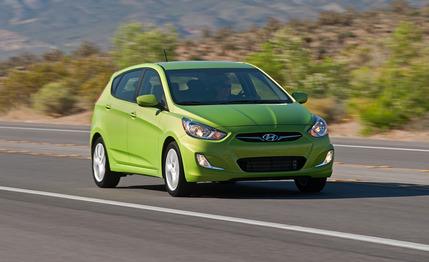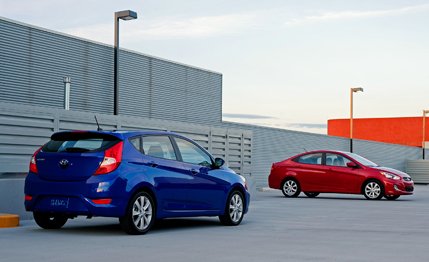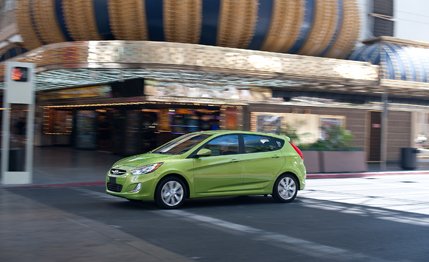
 Instrumented Test
Instrumented Test


We’re nothing if not thorough. In assessing the 2012 Hyundai Accent, we chose to test not one, not two, but three different variants: a hatchback with the manual transmission, a sedan with the automatic, and to get the full picture, a hatch with the auto. Yes, we could have tested that fourth body-and-transmission permutation, but that would’ve been silly.
Before the results are laid out, here’s a rundown of the players. For 2012, the Accent hatchback goes from three to five doors. The sedan is now the lineup’s value leader, with a base price of $13,205 for a manual. That base car wears the GLS badge (as do all sedans) and goes without air conditioning, power windows or mirrors, or even a radio—it has four speakers, but nothing to feed them music. No one’s buying that showroom-traffic model. Adding in those missing pieces runs $1750 (it’s called the Comfort package; we’d call it the “Bare Minimum” package), but the car still rides on 14-inch steel wheels. For $2750, you get that equipment plus an automatic transmission. Our automatic test vehicle was fully loaded, including the $1300 Premium package: keyless entry, body-color door handles on the outside and chrome pulls on the inside, piano-black interior trim, nicer cloth seats, steering-wheel-mounted audio controls, Bluetooth, cruise control, fog lights, and 16-inch aluminum wheels. See? Thorough.
Hatchback models come in two grades: GS and SE. The GS—$15,355 for a manual and $16,555 for the automatic—is equipped to a level similar to the GLS sedan with the Comfort package. We tested a pair of SE models, which include everything from the sedan with the Premium package, plus a rear spoiler, leather for the steering wheel and shift knob, and “sport tuned” steering. The SE starts at $16,555, and a grand more gets you the automatic. All three test Accents were decadently optioned with an iPod cable ($35) and carpeted floor mats ($95).


The Strongest Accent
The 2012 Accent is powered by a direct-injected 1.6-liter four-cylinder that makes 138 hp and 123 lb-ft of torque. The manual and automatic transmissions both have six speeds. The stick has longish throws and is accompanied by a lifeless, long-travel clutch pedal; it’ll be easy for anyone to move but doesn’t so much as hint at the location of its friction point. Despite those demerits, the manual is much more fun to interact with, allowing the driver to get the most out of the little engine. The automatic car feels as if it were missing a few of its 138 horses.
That feeling was backed up at the test track, where the manual hatch hit 60 mph in 8.0 seconds, 1.9 quicker than the auto-equipped hatch and 1.6 better than the automatic sedan. The manual dominated in every acceleration test but top-gear, since our procedure leaves a manual in its highest gear whereas automatics are allowed to downshift as they see fit. And to seal the deal, the manual got drastically better observed fuel mileage: 33 mpg versus 26 for both automatic cars. All 2012 Accents have EPA ratings of 30 mpg city and 40 mpg highway.
It can easily be extrapolated that a sedan with the manual would be about as quick and efficient. But it wouldn’t look anywhere as nice or be able to fit as much cargo. Anyway, that covers our vote for transmission.
The Game Where No One Wins
Not that this is a competition, but scoring the steering systems was a challenge all its own. The sport-tuned steering in the SE hatchback? We’re pretty sure it was playing Hide the Feedback. It’s well weighted off-center, but keep turning the wheel, and the weight disappears and then comes back. The nonsporty steering we sampled in the sedan has an acceptable heft with a more linear build. The system is hardly stellar, but it beats the confused steering in many other Hyundais, like the aforementioned SE and the Sonata.
The suspension could also use some work. The Accent’s springs are soft, which, along with the 2012 car’s 2.8-inch-longer wheelbase, provides a comfy ride on the highway, but the softness contributes to body roll in corners. And there’s a lack of wheel control over rough pavement that can lead to some harshness. For the kind of driving Accent buyers are likely to do, the compromised ride and handling should be acceptable, but there are better dynamic players in this class, like the Honda Fit and the new Chevy Sonic.


Interior refinement was a mixed bag. All three cars have quiet cabins, with the engine hardly audible at idle. The décor has been livened up from last year’s; design trickle-down from the Elantra and Sonata is evident and welcome. But the economy goals of the Accent show themselves with a lot of hard plastic, including a sharp ledge where the driver’s left elbow would want to rest, and the sedan’s plastic steering wheel felt particularly low-rent. The layout is cohesive—if a bit busy with its many shades of plastic—but we wish for some soft-touch points somewhere.
The Other Obvious Comparison
There is yet another small Korean option that does offer a more upscale feel, though. It’s called the Rio, and Kia makes it. It happens to ride on the same platform as the Accent and share the Hyundai’s powertrain. The Rio offers features that are unavailable on the Accent, like leather seats and navigation. But the Accent holds two advantages over the Rio: wider availability of the manual transmission and more room in the cargo area. The Rio hatch sacrifices about a third of the Accent’s stuff space in the name of style.
The Accent is a good, efficient midpack entry in the growing little-car segment. And like other new Hyundais, it’s a lot better than the car it replaces. The case is pretty clear for the manual, and as long as you’re not looking for a stripped version, the hatch and the sedan cost about the same with normal equipment. Our choice in the lineup is therefore the manual-transmission hatch, a car that recently finished fourth in a six-car comparison test. It’s a thorough improvement, but the rest of the segment has stepped up its game, too.